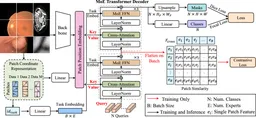

Revolutionizing Medical Image Diagnosis with PatchMoE AI Technology
Enhancing Medical Diagnoses with AI
In recent times, artificial intelligence (AI) has significantly advanced medical imaging, providing healthcare professionals with essential tools to support diagnostic processes. A groundbreaking development from Waseda University, known as PatchMoE (Patch-based Mixture of Experts), has recently shown promising results in this field by improving the accuracy of medical image segmentation by 3.04%.
The Need for Innovative Solutions
The integration of AI in medical imaging has faced challenges, notably when dealing with various resolutions and annotation methods across multiple datasets. Traditionally, it has been challenging for a single AI model to handle different medical images at once, leading to inefficiencies and inaccuracies.
Researchers from Waseda University, including Doctoral student Wang Jiazhe, Professor Osamu Yoshie, and Lecturer Yuya Ieiri, have developed a pioneering technique that divides images into smaller patches while simultaneously retaining three-dimensional positional information. This method provides accurate learning from diverse datasets indicating various medical conditions, such as retinal blood vessels or abdominal organs.
PatchMoE: A Game Changer in Medical Imaging
The core innovation of PatchMoE lies in its ability to concurrently process heterogeneous medical images within a single AI framework. This model utilizes a novel approach combining patch-based processing with the Mixture of Experts (MoE) framework to yield higher accuracy in medical imaging tasks:
1. Patch-based Processing: The image is divided into smaller patches, each associated with three-dimensional information that identifies the relevant dataset and its respective characteristics. This allows for effective learning about various datasets, maintaining essential spatial structures and relationships.
2. Dynamic Expert Selection: By employing a mixture of experts, this system can dynamically select the most appropriate model for specific medical tasks, effectively reducing interference and maximizing precision in segmentation tasks.
The PatchMoE approach ensures that the AI can tackle variations in imaging data, thereby overcoming the obstacles that typically hinder performance due to differences in resolution and annotations. Instead of needing specialized models for each task, this technology allows for a unified model that can be applied across various medical imaging scenarios.
Validation and Anticipated Impact
Initial testing of PatchMoE has demonstrated its efficiency across four distinct medical datasets: the DRIVE retinal dataset, HVNIR near-infrared vessel images, Kvasir-SEG gastrointestinal polyps, and abdominal organs from the Synapse dataset. The results indicate that the model not only surpassed existing methodologies like GCASCADE but also yielded a noteworthy improvement in accuracy.
Beyond enhancing diagnostic accuracy, the implications of this research are significant for practical healthcare applications. By utilizing a single model for varied medical imaging tasks, the need for separate AI systems reduces developmental costs, while also streamlining the integration of image data from different institutions. This adaptability is expected to be crucial for facilities with limited datasets or diverse imaging configurations.
Future Prospects and Challenges
Despite the promising results, the PatchMoE system currently relies on pre-defined dataset identifiers, which may limit flexibility when faced with unknown datasets or more nuanced medical imaging tasks in the future. Approaching these challenges will require the development of a more generalized expert-selection mechanism.
Additionally, while the research has predominantly focused on 2D medical images, expanding to 3D imaging modalities, like CT and MRI, remains a crucial direction for future work. Such enhancements will further broaden the potential applications of PatchMoE in real-world healthcare settings.
Researcher Insights
The researchers involved in this study have expressed optimism regarding the versatility of PatchMoE. As different resolution and annotation standards are common in clinical environments, a unified AI model is highly advantageous. The team is committed to further refining and validating PatchMoE with more diverse image types and clinical applications in mind.
Conclusion
In conclusion, PatchMoE embodies a significant leap forward in medical imaging technology. By facilitating finer segmentation across varied medical images, this AI framework stands poised to enhance diagnostic accuracy and efficiency, paving the way for more transformative applications in the healthcare sector.
Research Publication Details
- - Journal: Neural Computing and Applications
- - Title: Conducting patch contrastive learning with mixture of experts on mixed datasets for medical image segmentation
- - Authors: Jiazhe Wang*, Osamu Yoshie, Yuya Ieiri (Waseda University)
- - Publication Date: May 8, 2025
- - DOI: 10.1007/s00521-025-11234-1

Topics Health)










【About Using Articles】
You can freely use the title and article content by linking to the page where the article is posted.
※ Images cannot be used.
【About Links】
Links are free to use.